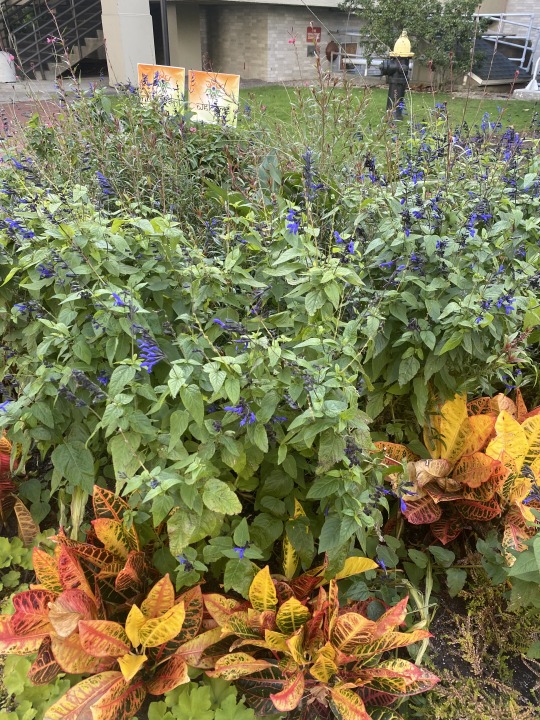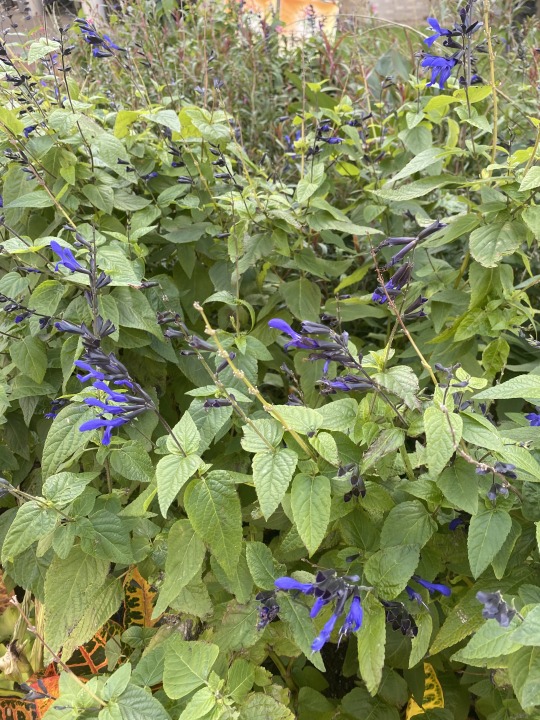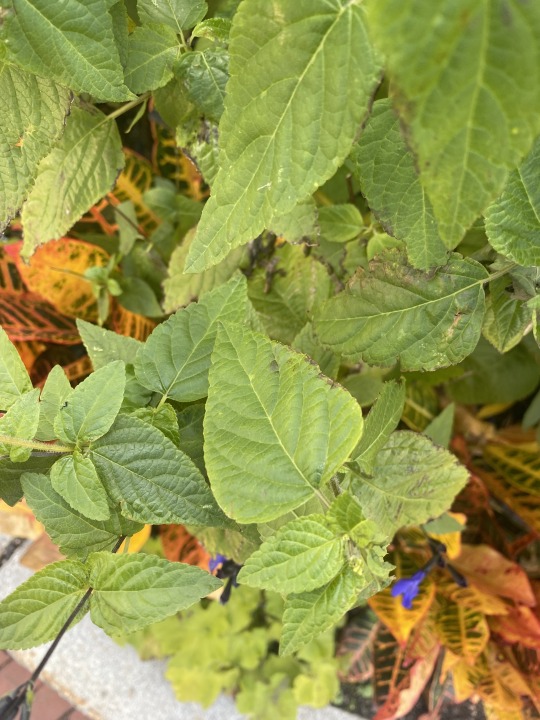#salvia guaranitica
Explore tagged Tumblr posts
Text



Anise-scented sage (Salvia guaranitica)
58 notes
·
View notes
Text

The blooms of Salvia guaranitica ‘Black and Blue’. I grow them not for their looks—they’re a lot of foliage for the amount of bloom— but for their popularity with hummingbirds who visit their flowers many times a day.
238 notes
·
View notes
Text

Salvia guaranitica 'Black and Bloom' / 'Black and Bloom' Anise-Scented Sage at the Sarah P. Duke Gardens at Duke University in Durham, NC
#Salvia guaranitica 'Black and Bloom'#Salvia guaranitica#Salvia#lamiaceae#Black and Bloom Anise-Scented Sage#Anise-Scented Sage#Hummingbird sage#Sage#Plants#Flowers#Nature photography#photographers on tumblr#Sarah P. Duke Gardens#Duke Gardens#Duke University#Durham#Durham NC#North Carolina#🌺🌻
10 notes
·
View notes
Text
Blue flowers: Salvia guaranitica / Anise Sage
Red flowers: Salvia coccinea / Scarlet Sage
Bridget watching a hummingbird at the flowers.
#Salvia guaranitica#Salvia coccinea#Salvia#Anise Sage#Anise-Scented Sage#Scarlet Sage#Blood sage#Sage#Flowers#Plants#plantblr#plant identification#taxonomy
3K notes
·
View notes
Text

hellooo! found this old photo, wanna say it's hummingbird sage, Salvia guaranitica, but I could be wrong
such a vivid purple!
#not a bug but still wanted to share :)#nature#plants#flowers#photography#sage#aesthetic#purple#purple and green#flower
4 notes
·
View notes
Text
The Lantana and Verbena Report: Did they attract pollinators as you promised?
(L) Coleus in front of ‘Little Joe’ Joe Pye Weed; (R) Persian Shield with sweet potato vine.
About a year ago I asked you guys – the savvy, experienced gardeners who read this blog – for what “Potted Annuals for Pollinators” you’d recommend. I was unhappy with some annuals I’d been growing near my front door – which do soooo well but attract nothing. But what could I grow instead, here and in the tomato-red pots in my back garden where the ‘Standing Ovation’ Little Bluestem weren’t standing after all, and were so lackluster that even a commenter here on the Rant called them “underwhelming”? The truth hurts!
(I’m keeping the Persian Shield+sweet potato vine combo shown above despite their lack of appeal for pollinators (though holes in the vine tell me it’s supporting something). Look how great they still looked on November 1 when this photo was taken! And in this spot very close to my front door, I’m okay with no flowers and no bees, which I don’t want in my house.)
Back to the question I asked readers – out of concern for wildlife, sure, but also, selfishly, so that I could enjoy watching them from my patio – your answers were almost thrilling in the possibilities they opened up for this old gardener.
You suggested:
Annuals: Salvia ‘Lady in Red,’ butterfly sage (Salvia guaranitica), Salvia guaranitica ‘Black and Blue’, blue salvias generally, lantana (several votes), verbena, verbena bonariensis, pentas, ‘African Blue’ basil, bronze fennel, zinnias, Anise hyssop (Agastache foeniculum) (several votes), ‘Truffela Pinks’ Gomphrena, Lacy Phacelia, Teddy Bear sunflowers.Perennials: Red Valerian, lavender, Calamintha nepeta, single dahlias, catmints, gaillardias, “almost anything in the mint family, which includes Salvias,” wax begonias for hummingbirds, and as a filler, small hostas like ‘Golden Tiara’ or ‘Rainbows End.’
Wow!
What I Bought – Lantana ‘Red Spread’
After reading Ranter Elizabeth’s praise for the annuals she buys online, I chose one of her favorite suppliers (Select Seeds) and ordered some lantanas, and boy, did they perform! They bloomed like crazy until the first hard frost, and the growth pattern is perfect – mostly horizontal, so there’s need to hack them back to prevent flopping. I love the bold, vibrant color! Another wonderful surprise is that they don’t need deadheading. Not only do they bloom just fine without it, but the dying blooms (above) still look good right up until they fall off, so why bother?
Pollinator-wise, they performed like the champs you guys promised they’d be. Honestly I’d need a much better camera to capture the critters in stills, but I took videos throughout the season and I’ll have a short compilation to show you soon. (Preview: it’s the hummingbirds, sometimes two at a time, that steal the show.)
Here in my back garden, by mid-July I’d given up on the grasses in these pots and replaced them with some ‘Havana Red Sky’ lantanas that I found at my local farmer’s market. They took off right away and at the end of the season they were this size. And what a great match for the pots!
I was also happy to learn that lantanas are less thirsty than other annuals – I don’t think I ever saw them wilt.
What I Bought – Verbenas
The other completely new-to-me plant I bought from Select Seeds is this ‘Vanity’ verbena, which did attract some bees and butterflies but didn’t have much impact in my border. I’m going to try a shorter, bushier variety next time.
Extended Season for Pollinators – Done!
My tiny front garden was already attracting critters to the Joe Pye Weed, bronze fennel, Nepeta and wood aster, but with the addition of tropical annuals like verbena and especially lantana, the wildlife action now goes on continuously for a very long season.
Happier Gardener – Done!
So yeah, I love upping my garden’s game at performing important eco-services, like supporting pollinators.
But I’ll tell ya, adding SO many flowers to this small space outside my front door, near the patio where I sit and gaze upon the garden – that’s been thrilling! The combination of floral beauty with stunning insects swarming over them in the sun. You could say it’s upped my mental well-being.
Flowers just make us happy! They attract people to gardening and then reward their efforts with beauty to be enjoyed by them and their family and visitors.
Next month I’ll be ordering even more of your suggestions, for planting in pots and also to fill in open spots in my borders:
More ‘Red Spread’ lantana, plus some ‘Cherry Sunshine’‘Graffiti’ pentas‘Lollipop’ verbena‘Black and Blue’ salviaCosmos seedsPurple Bell vineI’ve already ordered a dwarf canna from a specialist, to replace the (nonblooming) banana in my largest pot.
That’s a lot to look forward to, for not a lot of money, or effort.
The Lantana and Verbena Report: Did they attract pollinators as you promised? originally appeared on GardenRant on December 22, 2023.
The post The Lantana and Verbena Report: Did they attract pollinators as you promised? appeared first on GardenRant.
Read More
0 notes
Text
Salvia guaranitica Anise- Scented Sage





This plant was photographed on Northeastern University's arboretum near the Curry Student Center
Basic Facts
The cold hardiness zones of this plant are zones 8 to 10 and it can bloom from July to frost. It prefers full sun, medium water, and well drained loamy soil. This plant is also a subshrub that can grow 3 to 5' tall. It has 2 inch blue flowers that are two-lipped and tubular
Design
Salvia guaranitica does well in containers and can even be used in beds, borders and cottage gardens. Some cultivars of this plant should be propagated from cuttings and ensured that not too much shade is given. After the last frost date, only then should the plants be set out. Also to encourage more bloom, be sure to deadhead spent flowers.
Bird attraction
This plant does well at attracting pollinators, butterflies, and hummingbirds because of the flowers it produces. Hummingbirds are attracted to nectar, meaning that this is a plant that acts as a food source for birds!
Sources
https://www.missouribotanicalgarden.org/PlantFinder/PlantFinderDetails.aspx?kempercode=c834
https://blogs.massaudubon.org/yourgreatoutdoors/say-hello-to-hummingbirds/
0 notes
Video
Salvia guaranitica by hirorin 2013
#公#guaranitica The#Hiroshima#Botanical#Garden#flower#park#サルビア・ガラニチカ#公園#公園・農園#広島市植物公園#草花#広島市#広島県#日本#植物#flickr
0 notes
Text
ough Salvia guaranitica is sooo pretty but idk if I could keep it in my balcony
0 notes
Text

Zinnia and salvia yesterday morning.
#pennsylvania#flowers#garden#zinnia#zinnia mazurkia scarlet cream#salvia#salvia guaranitica black and blue#gardeners on tumblr#plants#plantblr#august#summer
176 notes
·
View notes
Text

Salvia guaranitica 'Argentina Skies' / 'Argentina Skies' Anise-Scented Sage at the JC Raulston Arboretum at North Carolina State University in Raleigh, NC
#Salvia guaranitica 'Argentina Skies'#Salvia guaranitica#Salvia#Lamiaceae#Argentina Skies Anise-Scented Sage#Anise-Scented Sage#Sage#Plants#Flowers#Nature photography#photography#photographers on tumblr#Jc raulston arboretum#north carolina state university#Ncsu#nc state#Raleigh#Raleigh NC#north carolina#🌺🌻
2 notes
·
View notes
Text
A note to everyone- salvia apiana is endangered due to over harvesting, but there’s so many types of sage, both similar and different, that are easy to grow on a balcony, front porch, or in a sunny window, or that can be bought for good prices.
Some fun and interesting varieties of sage below the cut, courtesy of so, so much time learning about this stuff
Salvia leucophylla
Lovely flowers and tall stalks, with more leaves growing near the ends and middle of the stem. Easy to harvest and dry.


Salvia officinalis, like in the post above, but I love this one too much to not include pictures
My favorite, especially the ones with purple in the leaves. A beautiful variety to have in your garden, and a powerful cleanser. Especially with the color purple corresponding to intuition, enlightenment, and wisdom.


Salvia guaranitica
This one smells and tastes like licorice. Also the bright blue flowers attract hummingbirds, and other pollinators, earning this plant’s nickname as hummingbird sage


Salvia elegans
These bright red flowers are also extremely attractive to pollinators, and many varieties smell much like citrus or pineapple. Great for working with luck, abundance, and confidence

Salvia fruticosa
This is actually the one you’re most likely to encounter in the world, as it dries in a more white color, and is often sold under the same name as salvia apiana. A lovely plant in its own right, growing plentifully in the Mediterranean and Eastern Europe.

And lastly, salvia argentea
This one is a beautiful silver color, with wide fuzzy leaves. You’re not going to find a better sage to withstand colder climates, hardy all the way down to 5 degrees F. This plant’s hardiness has earned this plant the Royal Horticultural Society’s Award of Garden Merit.



🖤✨
#green witch#witchblr#witch info#witchcraft#herbalism#sry for hijacking a post#but there were so many interesting sages#also- sages are part of the mint family along with basil and rosemary#nearly every plant in the family can be crossbred or can exchange flavors/scents if grown together
26 notes
·
View notes
Photo

サルビア ガラニチカ Anise-scented sage (Salvia guaranitica)
158 notes
·
View notes



